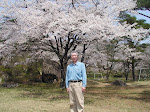舟繋ぐ石の袂の青田かな
fune tsunagu ishi no tamoto no aota kana
The boat-tying stone
neighboring
the green paddy field
Notes:
After that, Basho and his
party left for the opposite shore, where they landed from their boat, and they
saw the cherry tree that stands as a memento of 西行法師(Saigyo
hoshi)(1118-1190), Saigyo. Then they called at the temple standing nearby.
In those days it was called the Ebb-and-Flow-Pearls Temple(干満珠寺)(Kanman ju ji), which is now
called 蚶満寺 (Kanman
ji), the Kanman-Temple.
My photo and haiku are about the present-day Kisakata.
Hidenori Hiruta (蛭田秀法)










